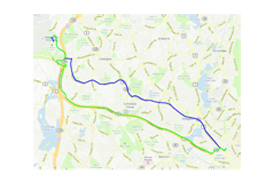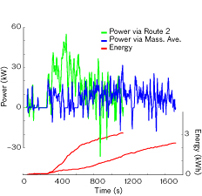Publications
Lab Notes
| HYBRID TECHNOLOGY A Route to Energy Savings |
Posted November 2010 |
Predictive control of plug-in hybrid vehicles will analyze your route to work and optimize battery and gas usage. |
|
The graph of power demands during Nicholas Judson's drive from Lincoln Laboratory to his home in Cambridge, displayed on his computer screen as a series of vertical lines, would make perfect sense to anyone familiar with the route. There's the increase in power consumption as he gets on Route 128 and picks up speed, a brief drop as he slows down for the off-ramp to Route 2, and a precipitous decline as he goes down the steep hill from Belmont into Arlington. The graph of his morning commute from home to laboratory is pretty much a mirror image. Measurements made when he skips the highways and sticks to Massachusetts Avenue through Lexington show a trip that takes about ten minutes longer, but uses about 20 percent less energy.
 |
 |
The route chosen for a trip can have a big effect on power and energy usage. Prior or assumed knowledge of the upcoming destination and the required power profiles, which depend on the route (green signifies Route 2; blue is Massachusetts Avenue), driver, average speed, changes in altitude, and many other factors, will affect how the algorithm controlling the use of stored energy in the vehicle will meet upcoming power requirements. (Image is copyrighted 2010 Google, map data copyrighted 2010 Google.) |
|
Judson and his colleagues Alan Millner and Bill Ross in the Advanced Electro-optical Systems Group hope that gathering data on power demands during driving will help make plug-in hybrid electric vehicles (expected to be introduced in the next few years) much more energy-efficient. They're aiming to provide such vehicles with predictive control, a system that makes decisions on when to use the battery or gasoline to power the engine. By timing the trip so the battery reaches its minimum charge just as the driver reaches his destination, they predict they can get a 7 to 10 percent boost in engine efficiency, raising mileage to roughly 71 miles per gallon from the 66 mpg expected from certain plug-in hybrid electric vehicles.
The idea is to use the gasoline engine only at its most efficient operating point, while using as much battery power as possible. "Any battery power that isn't used up because you've used gasoline instead, means higher cost because gasoline costs more than electricity for the same power," Judson says.
"Now you can use any kind of power source you want for transportation, rather than being stuck with gasoline or diesel fuels," says Millner. Many sources of electricity contribute far less to global warming than oil and would allow gains in efficiency with the use of central power generation. Millner says that if half the passenger cars in the United States could be converted to plug-ins that get 100 mpg, it would lead to about 500 million fewer tons of carbon dioxide being spewed into the atmosphere annually, roughly an 8 percent drop in emissions. It would also mean saving an amount of energy comparable to what the U.S. purchases from the Middle East.
In a hybrid vehicle, the gasoline engine kicks in when there's a demand for increased torque, caused by rapid acceleration or climbing a slope. But it also turns on in an effort to keep the battery charged at a certain level. In a hybrid that doesn't plug in, such as today's Toyota Prius, the system tries to maintain a battery charge of around 50 percent of capacity. In a conventional plug-in, the battery drops from nearly a full charge to roughly 20 percent, and then uses gasoline to maintain that level until it can be plugged in again. In the scheme Judson, Millner, and Ross are working on, the battery drops steadily from a full charge to the minimum—about 20 percent charge—with the aim of hitting bottom at the end of a trip when it can be plugged into the electrical grid and recharged.
 Battery power consumption can be optimized further than what current hybrids (and proposed plug-in hybrids) consume. With predictive control, the battery can be used throughout the entire trip, allowing the gasoline engine to run closer to its optimal point of efficiency, thereby saving significant amounts of fuel.
Battery power consumption can be optimized further than what current hybrids (and proposed plug-in hybrids) consume. With predictive control, the battery can be used throughout the entire trip, allowing the gasoline engine to run closer to its optimal point of efficiency, thereby saving significant amounts of fuel.
A predictive control system would gather route and elevation data from a global positioning system (GPS) navigation system in the vehicle, along with data already available in the car's computer systems, and learn about a driver's trips and driving habits. Drivers could either tell the system where they were headed, or the system could figure that out on the basis of experience—if it's 8:30 a.m. on a weekday, it would know the driver is probably headed to work, for instance. Knowing when the demands for high torque would come, it could use the battery as much as possible and level the load on the gasoline engine over the entire trip, thereby operating the engine at optimal efficiency. And instead of using pre-set parameters, such as battery charge levels, to switch to gasoline, the system could make decisions on the basis of the trip. For instance, if the battery were getting low but the car was two minutes from home and had a little battery energy left, it could decide not to use the gasoline engine.
Judson imagines the predictive control algorithms they are developing could be included in GPS navigation systems. Such a setup would base its actions on what it learns about a particular driver's driving habits and usual routes. Standard commercial systems could also be designed to tie into map systems and other data to apply the algorithm to unfamiliar routes. For instance, a route with a lot of traffic lights could be predicted to be less efficient than a trip along a freeway because of the numerous slow-down/speed-up instances. Or the system might be linked to real-time traffic data and suggest an alternate route that's not only smoother but more energy-efficient. Judson even speculates that some people might opt for slightly longer routes to reduce their energy consumption.
There are limits to how useful data from sources outside the car would be. Individual factors such as driving habits and even tire inflation are likely more important variables, Judson says. But he's also looked at some publicly available GPS data that measured driver behavior for about 200 vehicles in St. Louis over a period of ten weeks. What the data showed was that the range of accelerations in real-world driving is far broader than that used in the government standards used to give mileage ratings for cars.
The Laboratory's research program includes not only the predictive control but also an effort to optimize the batteries and bring their costs down. Millner says that plug-in vehicle batteries should not only draw from the electrical grid but also feed power back into the grid, thus smoothing out power demands for buildings and reducing costs, making the whole plug-in vehicle infrastructure more economical. For example, if the car "sensed" that it had more than enough reserve battery power to get itself back home (where it could recharge during off-peak hours of electrical consumption), it could feed some of that power into the grid.
The team has built a vehicle energy lab in the basement at Lincoln Laboratory and is awaiting a test vehicle they can use to gather more real-world data. They spent last year on analysis and modeling, and hope to build a working system in 2011.